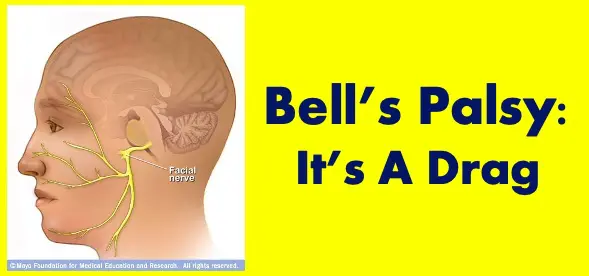We’ve been treating several patients over the past two months who are suffering from Bell’s palsy, so we thought it a good time to share some information about it. Bell’s palsy is a condition marked by sudden weakness in one’s facial muscles that make it appear as if one side of your face is “drooping”. It is due to temporary paralysis or inflammation of the seventh cranial nerve, the facial nerve, and affects approximately 40,000 people in the United States every year. Symptoms include rapid onset of facial paralysis that make it difficult to close your eye, smile, chew or puff out your cheeks. Drooling, tearing, headache and increased sensitivity to sound on the affected side are also common. Though typically temporary, symptoms can last up to six months. In a few cases, however, the symptoms don’t resolve.
The cause of Bell’s palsy is unknown, but is thought to be a reinfection of a dormant viral infection such as herpes simplex, chickenpox and shingles (herpes zoster), mononucleosis (Epstein-Barr), cytomegalovirus, adenovirus, rubella, mumps, flu (influenza B), hand-foot-and-mouth disease (coxsackievirus)1 and there have been several reports of Bell’s palsy resulting from COVID-19.2 Bell’s palsy is triggered by impaired immunity from stress, sleep deprivation, physical trauma, minor illness or autoimmune syndromes.3 People who are obese or have diabetes or hypertension are more at risk, as are pregnant women. Dr. Lauren has personally known several women who have suffered from Bell’s palsy during pregnancy and post-partum.
Treatment for Bell’s palsy typically includes steroids like prednisone, intended to reduce inflammation, and antivirals, intended to combat the latent virus. Both tend to have limited results. Over-the-counter medications can help relieve pain (though most of the patients we’ve treated don’t complain of pain, they just want to look and feel normal again.) Physical therapy such as facial massage and exercises (think smiling, puffing out your cheeks, etc.) can help stimulate the muscles and nerves.
Acupuncture treatments, especially when started shortly after the onset of symptoms, can be a game changer as it reduces inflammation and helps to stimulate the nerves back into action. A systematic review of randomized controlled trials involving 1541 people concluded that acupuncture can be a highly effective treatment for patients suffering with Bell’s palsy.4 Patients typically require three treatments per week for several weeks and most make a full recovery. If you know anyone suffering with Bell’s palsy, encourage them to seek treatment right away and if you have any questions, feel free to email Dr. Lauren.
References:


